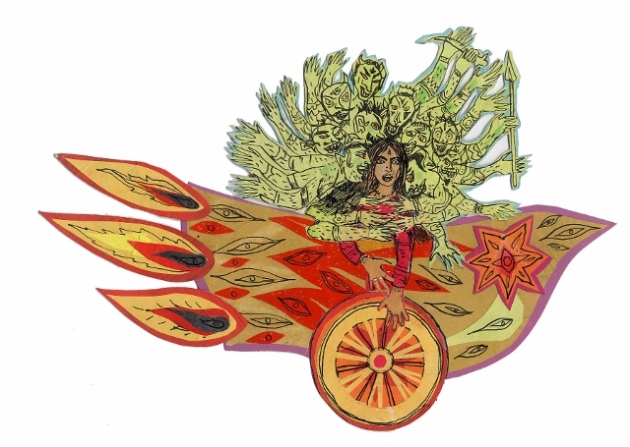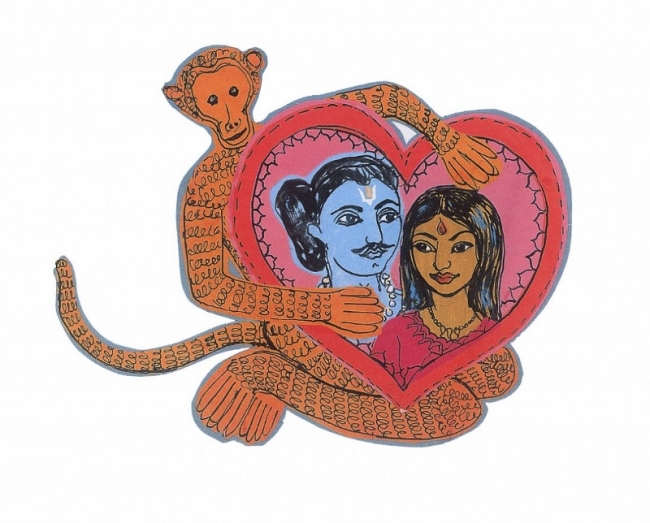Rama and Sita – Path of Flames, told by Sally Pomme Clayton, illus. by Sophie Herxheimer. London: Frances Lincoln Children’s Books, 2010.
Storyteller Sally Pomme Clayton is equally adept at performing her stories for an audience as she is at committing them to the printed page. When she set about retelling the Ramayana, the two-thousand-year-old epic love story of India, she brought the oral storyteller’s sense of immediacy into the book right away, with a charming frame story. In it, she, the author, visits a junk shop and buys a brown wool monkey, a knitted toy that surprises her by speaking as soon as they are outside. He announces he is Hanuman, the Monkey God, the Divine devotee of Rama and Sita. The author is skeptical of this, since his tag says “Made in China.” Hanuman explains that he has traveled widely over the centuries–from his home in India to Indonesia to Cambodia, Vietnam, China, and now a shop in Britain–and he says,
wherever I go, people think I belong to them. … I’ve been traveling for two thousand years. You see, I love the story of Rama and Sita, and wherever it’s told, I’m there too, listening. It’s a brilliant story, it’s got magic and adventure, scary bits and funny bits–and I’m in it! You’re going to be telling the story next, aren’t you?
A great way to start.
Clayton’s style is conversational without being too informal, and she packs incidents into her narrative with brisk economy, keeping many important details. But Rama and Sita – Path of Flames is also a wonderful picture book–the second in my series featuring notable illustrators and illustrated children’s books. The illustrator, Sophie Herxheimer, paints her characters with black brush strokes and colored wash, and the figures float freely around the white pages of text without any tethering landscape. The focus is squarely on the characters, from the most beautiful–Sita and Rama–to the most bizarre–the rakshasas (demons), with fearsome faces, often several, on many heads! The main arc of the story can be mapped as:
Miraculous Births–Marriage Test of Sita–Exile of Rama and Sita–Abduction of Sita–Rescue of Sita–Trial by Fire–Restoration.
Both Rama and Sita are born in answer to fervent prayer by their royal parents after a period of intense yearning. They have a divine destiny to restore cosmic harmony, which has become unbalanced through the incursion of too many demons into the human realm. Rama is the eldest son of King Dasharatha, the son of the king’s first wife; he has three brothers, born to his father’s two other wives, and the four brothers are all mutually devoted. Sita is the daughter of King Janaka, whose prayer was answered when he discovered a beautiful infant girl in the “furrow” (sita) of his field one day; she was a gift of the Mother Goddess Shri, her essence in human form.
When she was fully grown, Sita chose her husband in the swayamvara ceremony, in which suitors would vie to perform the marriage test she set them: to lift the great god Shiva’s golden bow. After many tried and failed to budge it, Rama was able to lift it easily, and even bend it to be strung, breaking it in half in the process. Sita accepted Rama as her husband, and they were happy for a time, until King Dasharatha was swayed by his jealous second wife to install her own son Bharata as his royal successor, displacing Rama. She further demanded Rama’s exile from the kingdom. Bharata objected fiercely to this, but obedient to his father, Rama accepted this hardship without complaint, as did Sita. Rama and Sita retired to the forest, along with Rama’s brother Lakshmana. The loyal Bharata placed Rama’s sandals on the throne in his stead, until his hoped-for return someday.
Although Rama and Sita managed well in the simple life of the forest, they were no longer as safe from the designs of the demons abounding there. Ravana, the ten-headed king of the demons, was obsessed with Sita’s beauty, and plotted to take her for himself. Both Rama and Lakshmana were lured away by illusion and trickery, leaving only a magic circle in the dust to guard Sita. Ravana quickly took advantage of this and put the rest of his plan to work.
Sita was not only beautiful but kind-hearted and virtuous, so Ravana lured her out of the circle by posing as a holy man, in need of food and water. When she stepped out to help him, he grabbed her and, resuming his fearsome demonic form, he summoned his magic chariot to fly them both to his kingdom in Lanka (Sri Lanka). The abduction of Sita is a dramatic climax of any version of the Ramayana, and artist Sophie Herxheimer makes the most of it with one of her most striking drawings:
In traditional Ramlila re-enactments of the story, the actor portraying Ravana wears a headdress with the required nine additional heads. I like how Herxheimer’s drawing is able to make the demon faces and arms cluster around Sita who is terrified and screams for help.
Rama and Lakshmana realize they have been tricked and begin their journey south to rescue Sita. They will enlist the aid of Sugriva, king of the monkeys, who sends his army to help them. Their heroic general Hanuman is a divine being distinguished by his deep devotion to Rama, whom he recognizes as an incarnation of the great God Vishnu. Hanuman is equally devoted to Sita and his outsized courage, along with Rama’s strength and devotion to her, will lead them all to prevail over the demons. But the detailed working out of this rescue is a wonder I will not spoil for any reader who is happily encountering this story for the first time!
The Ramayana is also a reflection of an ordered society, so the drama is public as well as a private emotional struggle. When Rama rescues Sita, his own jealousy is compounded by the societal norms that a wife will not spend time alone, unchaperoned, in the company of another man. The complexity of Rama’s doubt and Sita’s courage in demonstrating her faithfulness and integrity form the finale to the story. It is indeed a “path of flames” because Sita calls upon a trial by fire to uphold her innocence. Her purity is untouched, even walking through flames, and she is restored to Rama, their happy marriage, and a peaceful kingdom, where Rama and Sita will now rule as king and queen.
And what of Hanuman? He stays with them in humble service. Because he holds Rama and Sita in his heart at all times, he is a supreme model of devotion to God.
This retelling for children ends here, but the Ramayana tradition includes a further postscript where Rama once again allows himself to be swayed by doubts and gossip about Sita’s innocence. (Anyone who has ever watched tabloid television will know how readily people can sometimes entertain the worst notions about their neighbors, especially those who are famous.) Brave Sita is once again exiled, but this time by Rama himself; she is already pregnant and takes shelter with the sage Valmiki, the very poet who will sing this story, the Ramayana. Rama is eventually united with his twin sons, Lava and Kusha, but Sita returns to Mother Earth. Knowing this, I am reminded of the prophetic words early in this book, when Sita and Rama are first exiled to the forest by Dasharatha: “Sita had been born from the earth, and Earth took care of her child.”
There is no shortage of illustrated versions of the Ramayana for children, including the Amar Chitra Katha series of comics, popular among both children and adults.
The stories and characters which endure invite endless realizations by authors and illustrators. I recommend Rama and Sita: Path of Flames most highly as a witty, accessible retelling of this great epic of India, beautifully enhanced by its illustrator. Artist Sophie Herxheimer has posted a delightful video demonstrating how she works, brainstorming with brush and ink in hand to come up with new ideas for illustrations. She is a very entertaining teacher! At Sally Pomme Clayton’s website, you can see a video of her live storytelling of Rama and Sita: A Path of Flames, accompanied by tabla, violin, and other instruments.
Sita is 20th on The Fictional 100.
Links:
Related post:























Recent Comments